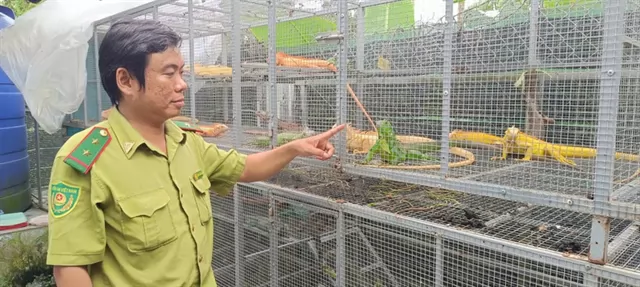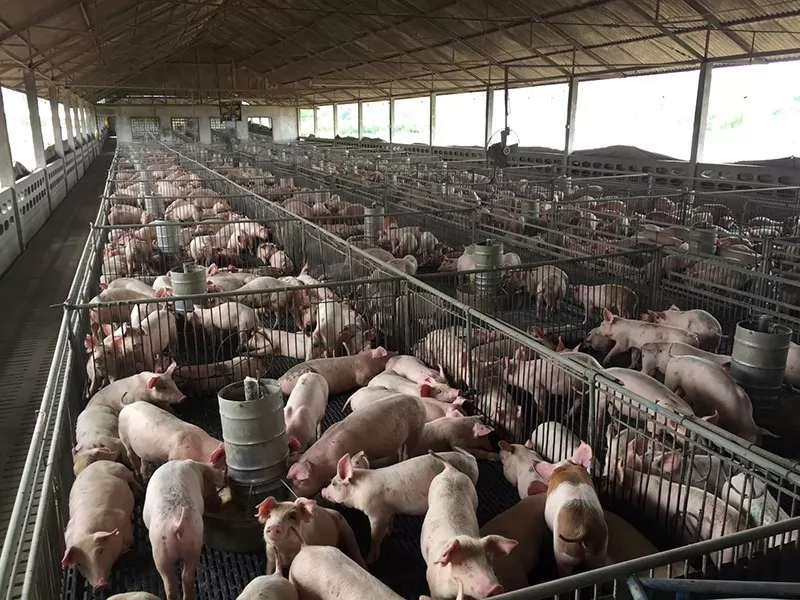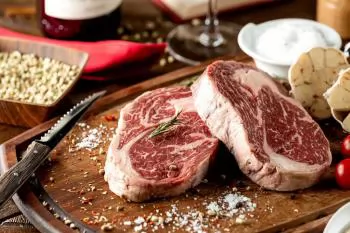Agricultural innovation key to capital's food security

Deputy Minister of Agriculture and Rural Development, Trần Thanh Nam (from left to right, the fourth man) and a delegation of officials visit the Mía chicken farm of Hadico Poultry Enterprises. Photos courtesy of Hà Nội Department of Agriculture and Rural Development
HÀ NỘI — High-value specialty crops and livestock are being developed to meet the increasing consumption needs of domestic consumers, in line with the comparative advantage of each locality, but more needs to be done, Deputy Minister of Agriculture and Rural Development, Trần Thành Nam has said.
“The city needs to continue to identify the unique advantages of each locality, select varieties of plant and livestock that have both high economic value and are sustainable, and put them into production. This will improve the lives of people in rural communities," he said.
Agricultural innovators like, Kiều Văn Lợi, can attest to the benefits of agricultural innovation. He began growing Rose Myrtle in Ba Vì District four years ago. What had previously grown wild with little perceived value has become a profitable enterprise.

The meeting organised by the Hà Nội Department of Agriculture and Rural Development aims to exchange production and consumption between enterprises and longan farmrers in Đại Thanh Commune, Quốc Oai District.
Lợi now harvest 500kg of sim fruit in 2020 at a cost of VNĐ40,000/kg. Almost all parts of the Rose Myrtle are processed into herbal medicine and are used to treat a variety of illness.
"Growing Sim is not difficult because it attracts fewer pests and diseases, takes less care, and has a much higher value than other crops I've grown before," he says.
It’s not only non-traditional crops that are finding a place among Việt Nam’s agricultural industry. Alternative business models are also flourishing.
In Hoài Đức District, Nguyễn Như Hảo, together with several other local farmers, established the Quế Dương Safe Pomelo Growing Cooperative. The cooperative provides technical and seed support to members, finds stable markets to sell to, and makes it possible to sign orders for large quantities.
With an average price of VNĐ35,000-40,000/fruit, the pomelo growers are earning profits from VNĐ500 million to VNĐ700 million per hectare per year. This is much more than they would earn selling rice which currently sells for around VNĐ13,000/ per kilogram.
Nguyễn Quốc Quân in Đường Lâm Commune, said he was breeding 300 Mía chickens in the garden.
Mía chicken is a breed of chicken known for its beautiful appearance, and firm and delicious meat.
It has been recognised by the Ministry of Agriculture and Rural Development as a national original breed and granted brand protection certificate by the National Office of Intellectual Property.
Mía chicken's earn Quân VNĐ150 million every year.
"This is a high income for farming households in this commune," Quân says.
Currently, the commune has more than 20 households raising Mía chickens to supply chicken meat and baby chicks as livestock for farmers in the township. Notably these chickens are raised free-range breeding and fed rice as opposed to industrially produced chicken feed.
Deputy Chief of the Coordination Office for the New Rural Development Programme in Hà Nội, Nguyễn Văn Chí, said that the city has developed models of planting trees and raising poultry unique to the conditions of each area.
"By focusing on growing crops best suited to the weather, terrain, and skill sets of particular localities, high economic efficiency can be achieved," he said.
"This approach has contributed to an increase the average income in rural areas to VNĐ55 million per person per year," he said.
Director of the Hà Nội Department of Agriculture and Rural Development, Chu Phú Mỹ, said that to improve efficiency, the agriculture sector has been coordinating with local communities to select a number of key fruit trees to develop. It has also expanded concentrated production areas and invested in infrastructure like irrigation, water pipes, electricity systems, and rural roads.
In recent years, for example, Quốc Oai District has converted hundreds of hectares of inefficient rice land into crops and livestock with a higher economic value.
In Đại Thanh Commune, the district has approved the conversion of all of their agricultural land to growing longan berries.
The city agricultural department in co-ordination with Quốc Oai District authorities have supported the development of new technology according to the Vietnamese Good Agricultural Practices (VietGAP). These are regulations on good agricultural production practices for agricultural and aquatic products in Vietnam.
The output of longan reached 2,500 tonnes with revenue of more than VNĐ50 billion (US$2.17 million) in 2020. — VNS
Maybe you are interested

UN must protect rights of world's poorest to nutritional benefits of milk and meat, say experts
More than 115 agrifood experts, government advisors and business leaders are calling for animal-source foods to be excluded from a UN declaration to eliminate trans-fatty acids.

Nearly 200 illegally bred iguanas found at unlicensed wildlife facility in An Giang
All 191 iguanas, identified as administrative violation evidence, were temporarily transferred to the Hòn Me Wildlife Rescue Station in An Giang for proper care and monitoring while the case is under investigation.

Booming pork demand sparks race among Vietnam's top pig producers
With pork prices high, Vietnamese producers like BaF and Dabaco are scaling up against foreign rivals.





